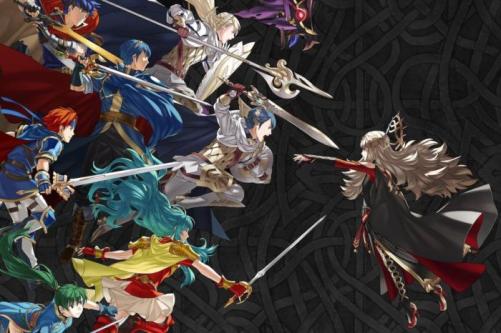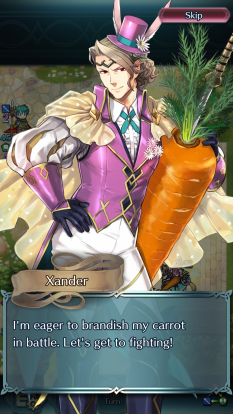
First released in February 2017, Fire Emblem Heroes was Nintendo’s third major foray into the world of mobile gaming after Pokemon Go and Super Mario Run. Its initial reception was mixed, but Heroes has benefited from substantial support and a steady stream of new content over the last year. With high production values, an impressive range of game modes, and surprisingly complex mechanics, Fire Emblem Heroes is a rich and enjoyable mobile game; albeit one inevitably diminished by the intrinsic mechanics of the free-to-play model.
Heroes is a “gacha” game, in which the player can earn (or buy) “orbs” to spend on unlocking a random selection of characters from across the venerable series. The decision to focus on Fire Emblem’s long list of well-loved characters was a canny one, ensuring that the game has an instant appeal to fans of the franchise. By now, Heroes sports an enormous roster of over 200, ranging from Smash Bros. favourites like Ike and Roy to Camilla and Corrin from the Fates games. You can earn enough orbs to pull new characters with some regularity, but if you’re determined to get someone in particular, then it could potentially cost you an awful lot of money. This dynamic is exacerbated by the release of special versions of popular heroes during time-limited events.
Your characters come in Gold, Silver, and Bronze versions, so even if you get a character you want (say, a silver Tharja), it might take a lot of investment to unlock their potential. Heroes has a variety of in-game currencies which you can use for levelling up and upgrading your characters and giving them new skills. Once again, you can earn all of these by playing the game, but there’s no question that dropping money on it would make the process a lot faster.
Playing Heroes feels like a heavily simplified, more casual version of the familiar turn-based tactical formula. Each brief map sees you deploy a team of four heroes, tasked with some simple objectives (nearly always defeating the enemy or surviving a set number of turns). You move your characters around an 8×6 grid, and the game can comfortably be played with one hand if you’re standing on the train. Heroes keeps Fire Emblem’s rock-paper-scissors weapons triangle, but dispenses with other iconic mechanics such as permadeath. So, you don’t have to worry about losing someone in battle – although they will lose any experience they gained on that map.

This is obviously a much less complex game in comparison to a “proper” Fire Emblem, but by the standards of most mobile games it’s still surprisingly deep. Your Heroes can be upgraded in a variety of ways, and there’s a lot of scope for customization by merging heroes and transferring skills from one character to another. In addition to the main story mode – which features three difficulty levels – Heroes also features Paralogues and side quests, an Arena mode, a Training mode, and seasonal special events. It’s an enormous amount of content for a free-to-play game, and the only sour note is that the quality of the writing during the campaign is disappointingly poor. The amount of time you can play is theoretically limited by your Stamina, which you have to expend to attempt certain maps. But over time, you earn various consumables which you can use to keep on playing; and really, Heroes is best played in short bursts anyway. It’s ideal for short bus rides or while resting between sets at the gym, but if you want to play for hours at a time, you’re better off playing something else.
In general, I have a dim view of games like this. The “gacha” or loot-box mechanic is akin to gambling, and it can easily exacerbate a negative dynamic wherein players spend increasing amounts of time in the game for decreasing rewards. Anyone who is prone to problems with gambling and impulse control should be very careful when playing any free-to-play game, and Heroes is no exception. The fact that it’s purely Player-versus-Environment – there’s no direct interaction with other players – mitigates things somewhat. But it’s still important to know what you’re potentially getting yourself into.
Heroes has great production values, with bright, colourful graphics, and explosive animations. The main selling point – the Fire Emblem characters themselves – are depicted during conversations and so on via appealing full-length portraits, and by cute, doll-like avatars on the game map and during combat. Most characters get a few voice lines, although I was disappointed to find that they’re not all voiced by the actors I remember (no Gideon Emery for Gaius, for instance). The music is excellent, and you’ll regularly recognize iconic themes from across the Fire Emblem franchise.

Fire Emblem Heroes has received excellent support from Nintendo and Intelligent Systems since its release, and with over 10 million downloads it is by far the most widely-exposed Fire Emblem game in history. For the most part, it’s an exhuberant, entertaining celebration of the Fire Emblem franchise, and it’s great fun seeing the likes of Lucina and Xander frolicking in bunny-themed outfits to mark the Spring seasonal event. But there’s no escaping that games like this have a dark side, too. With that caveat, and the observation that some people are probably better off avoiding this sort of thing entirely, this is an easy recommendation for anyone looking for a casual role-playing game on the go.
9/10

It’s nice to see Fire Emblem really take off in the West post-Awakening.
LikeLiked by 1 person